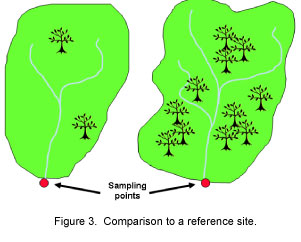
Sampling Design: Monitoring a reference site for comparison
| Upstream / downstream |
Reference site |
Reference condition |
| Downstream before and after | Historic data | Site runoff |
| Downstream before and after | Historic data | Site runoff |

Assumptions:
-
The reference site is similar enough to the sample location site that it will provide a baseline for comparison. This should be evaluated before implementation of the BMP.
- Data that are collected at the same time can be compared so water-year differences and other seasonal and annual variation is reduced.
- It can be difficult to find a good reference site, particularly if seeking an “unimpaired” or “natural” site.
- Be careful about comparing sites that are not sufficiently similar. At a minimum, streams of a similar order, flow, geology, stream type, elevation, and land use should be compared. The size, shape, geology, climate, vegetation, and land use of a watershed are all factors that can affect the response of the system.
- Use this when looking at long-term indicators (biological indicators).
- One of the challenges of this monitoring approach is finding adequate reference sites. If this approach is used to directly compare chemical data, the conditions under which the monitoring takes place should be considered (for example, baseflow compared to storm event runoff).
- It may be necessary to monitor upstream and downstream monitoring to assure that all potential impacts are captured.
Quick Links
Decision Tools
Objective
Temporal & Spatial Scale
Monitoring Considerations
Sampling Design
Data Analysis
Pollutant Properties
Resources
Additional Information
Glossary
National Water Quality Handbook
Contacts:
Nancy Mesner
Extension Water Quality
Specialist
Utah State University
435-797-7541
nancy.mesner@usu.edu
Ginger Paige
Water Resources Specialist
University of Wyoming
307-766-2200
gpaige@uwyo.edu
- ©2011 University of Wyoming |
- Disclaimer |
- Site questions or comments |
- Last updated: June 14, 2011
